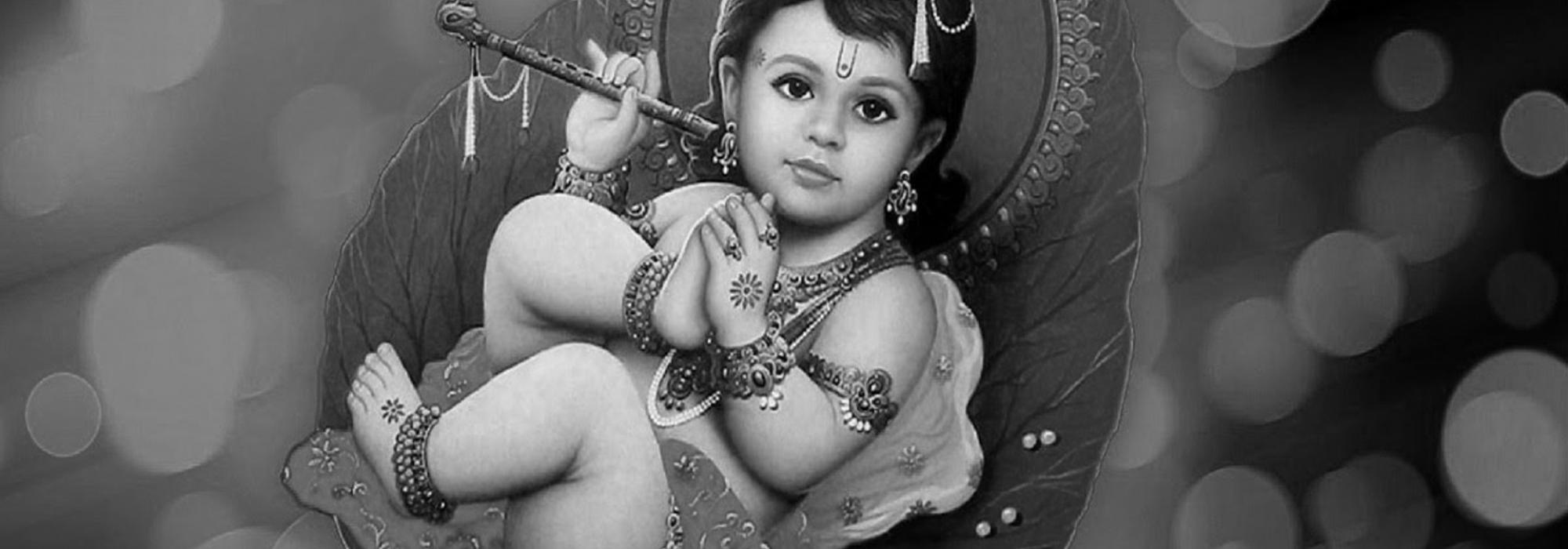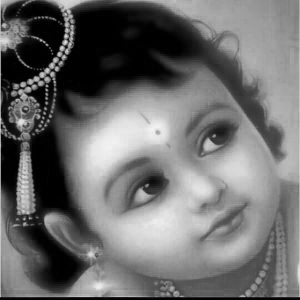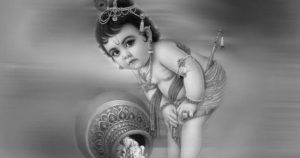The current series examines the literary and aesthetic value of the verses of Kṛṣṇakarṇāmṛtam and wherever possible, touches upon their application to music, dance and painting. The present part gives a brief introduction to the poet, his work and describes a few verses.
Kṛṣṇakarṇāmṛtam is a wonderful lyrical composition of three hundred and twenty eight verses in three parts (āśvāsas) by Līlāśuka (also known as Swami Bilvamaṅgala). Each verse is independent and self-complete, describing different imaginary episodes from Krishna's life and his qualities. As the name of the poem suggests, the verses are like nectar to the ears and the word 'amṛtam' also hints at the eternal nature of Krishna. It is for this reason, probably, that Krishna is rightly called a purāṇa-śiśu - a kid who is so old, but yet so new - relevant to all times.
Several verses from the Kṛṣṇakarṇāmṛtam are popular and many are quoted by people on various occasions, at times being unaware of the source of the verse. In this sense, the collection of verses has entered the community consciousness and has come down through several generations as an oral tradition. These verses have won the hearts of both the lay and the learned. The lucidity of the verses, their self-completeness, richness of emotion and the varied possibilities for application across art forms - have been the reasons for their all-time relevance. Though Bhakti, i.e., devotion flows as an undercurrent throughout the work, the poet touches upon different aspects and events related to Krishna’s life. Some verses are merely the poet's description of the external features of Krishna, while some are an attempt to capture his sublime being; while some verses speak of his association with the gopikās of Vṛndāvan, some speak of his innocence and mischievous nature as a child. Some of the verses are also addressed directly to Krishna by the poet, who out of his intense devotion and affection for his beloved deity tries to draw His attention towards himself
Some of the verses are rich in śabdālaṅkāra, i.e., beauty in form and metrical constructs - with alliterations, and many have a prominent arthālaṅkāra, i.e., figures of speech too. The verses span a range of rasas, which include but are not limited to śṛṅgāra, hāsya, vīra and karuṇa. It is for this reason, that the poetess of the Vijayanagara empire, Gaṅgādevī aptly pays her respects to the 'Karṇāmṛta-kavi', the poet who has fed our ears with the immortal nectar of verses. In her poem, Mathurāvijayam she says
मन्दारमञ्जरीस्यन्दि मकरन्दरसाब्धयः |
कस्य नाह्लादयानालं कर्णामृतकवेर्गिरः || (Mathurāvijayam - 1.12)
Who indeed can the words of the Kaṛṇāmṛta-kavi (Līlāśuka) satiate and who indeed will it not cause pleasure to? The words of the poet are like an ocean filled with the sweet nectar of the mandāra flower.
(It is worth noting that the the poetess has compared the poet's words to nectar of the mandāra flower, a divine flower, which adorns the gardens of the devas, the immortal deities)
We do not know much about the poet who penned the work. He has called himself ‘Līlāśuka’ in one of the verses in the poem and that is probably only his pen name. [Most scholars have associated him with the poet Bilvamaṅgala]. It is hard to ascertain his place and year of birth. It is thought that he was either from Andhra Pradesh or from Kerala, as his poems are very popular in those areas. We get to know from the work that the poet’s guru was called Somagiri and his ‘śikṣāguru’ (i.e., the one who gave him basic education or the teacher who taught him phonetics and pronunciation) was Śikhipiñcamauli. Līlāśuka probably hailed from a Shaivaite family, but Krishna was his favourite God. We also infer from the poem that he was under the patronage of a few kings and later took to writing devotional poems full time, as he felt that it is an insult to Sarasvatī, the muse of knowledge and learning, if he spent his words and creative mind only to write verses in the praise of kings.
The following verses give a glimpse of the variety spanned by the work.
कस्त्वं बाल? बलानुजः ! किमिह ते? मन्मन्दिराशङ्कया
युक्तं तन्नवनीतपात्रविवरे हस्तं किमर्थं न्यसेः ?
मातः कञ्चन वत्सकं मृगयितुं मागा विषादं क्षणात्
इत्येवं वरवल्लवीप्रतिवचः कृष्णः स पुष्णातु नः ॥ 2.82
As we all know, the young Krishna was mischievous and often stole butter from the houses in the neighbourhood of Gokula. Once when he had gone to steal butter, he was caught red-handed by the lady of the house (a gopikā) even as his hand was inside the pot of butter. The above verse captures the conversation that took place between the gopikā and Krishna.
"Who are you, lad?"
"Balarāma's younger brother"
"Why are you here?"
"Mistook this for my house!"
"Oh! Quite possible. But then, why is your hand in the pot of butter?"
"Oh mother! I've been searching for a little calf that's gone missing!" (... and I thought it might be hiding in this pot of butter. So I'm searching for it here)
We notice from the verse that Krishna is so smart that he doesn't even give out his name. He merely says that he's Balarāma's brother. Later on, should there be any trouble any trouble, he can easily shift the blame to Balarāma or some other brother of Balarāma! Moreover, if Balarāma had several siblings, this to easily add to the gopikā's confusion. When he tells the gopikā that he mistook it for his house, she thinks that it's a likely scenario, as the little boy could have got confused as all the houses of Gokula looked alike. When she further confronts him with the question "Why is your hand in the pot of butter?" the little one gets confused and makes up a silly reason. The poet goes on to say, "May Krishna, who gave such a (innocent) reply to the gopikā protect us!"
What happened next in the episode is left to our imagination - did the gopikā just laugh at the little boy's sweet innocence and send him off with a handful or butter, or did she catch him by his ear and drag him to his mother?
It is also interesting to note the the usage of the word 'mātaḥ' by the toddler Krishna. Unlike in the West, Indians use filial terms to address even strangers. So for instance, if we meet an elderly lady, we might address her as "Mother" or "Grandma" and if we meet a young man, we might call him "Son" or "Brother." Thus we see an extension of our family in the world, thus giving the true meaning for "vasudhaiva kuṭumbhakam." The construction of the verse in the śārdūlavikrīḍitam meter as a dialogue between two people is also interesting. Sanskrit literature is replete with such verses. Here, however, it feels as though Krishna is actually speaking his tender words and forms sentences only using a few words - just like any other innocent child that is learning to speak. That is how our daily conversations are anyway.
The above verse can be very nicely adapted to dance - either as a solo or as a duet with a young dancer playing the role of Krishna. It is needless to say that it would find its best representation through Bharatanrityam. A sañcāri can be elaborated before the beginning of the verse, depicting a young Krishna stealthily entering the house of a gopikā, looking around to make sure that no one is present and slowly putting his hand in the pot of butter. The lady of the house may then noiselessly stand behind him and watch him as he steals a handful of butter and catch hold of his ear / arm from behind. Little Krishna, caught red-handed then slowly turns around, a bit surprised and quite shocked, but immediately makes up the story. The verse can then be sung. For the sañcāri, a playful tune such as the kathana-kutūhalam or yaman-kalyāṇi, which is famous as Krishna's own rāga can be played on the flute. These are mere suggestions and creative artists certainly find a lot of scope for elaboration on this verse. One such choreography was done by Smt. Nirupama Rajendra of Bangalore and was presented by her on 8th May 2016 in Bangalore.
गोपालाजिरकर्दमे विहरसे विप्राध्वरे लज्जसे
ब्रूषे गोधनहुंकृतैः स्तुतिशतैर्मौनं विधत्से विधाम् ।
दास्यं गोकुलपुंश्चलीषु कुरुषे स्वाम्यं न दान्तात्मसु
ज्ञातं कृष्ण तवाङ्घ्रिपङ्कजयुगं प्रेमाचलम् मञ्जुलम् ॥ 2.83
This is a touching verse where the poet describes how to win over Krishna. We come to know about Krishna's preferences - what does he responds to and to what he does not. The poet says, "You relish your time rolling in the muddy waters in front of the houses of Gokula but you shy away from the elaborate rituals performed by the pious brāhmaṇas. You spontaneously respond to the mooing of a cow, but you respond only with silence when scholars eulogize you with hundreds of metrical verses of praise. You are ever-ready to become a servant to the women of Gokula even if they are of questionable character, but you are unresponsive to people who are performing tapas to have you as their master. Now I have understood Krishna. I can attain your lotus feet only through untainted and pure love."
In this verse, the poet makes use of wonderful contrasts to drive home his point - On one hand we have all the sanctified materials used in a yāga, performed by the brāhmaṇas, who proudly consider themselves are divinities on earth and on the other hand, we have the dirty waters in the unkempt yards of the gopālas, who are supposed to belong to the lowest strata of the society. Furthermore, we have the best and the most refined among human languages - Sanskrit and metrical verses recited in the language set to the three svaras (traisvarya) and on the other, we have the 'meaningless' mooing of a cow. What more - we have sages, who have won over their mind and senses and have been meditating, beseeching Krishna to be their master and on the other hand, women of Gokula, who are of questionable character, whose servant Krishna chooses to become.
विहाय कोदण्डशरौ मुहूर्तं
गृहाण पाणौ मणिचारुवेणुम् ।
मयूरबर्हञ्च निजोत्तमाङ्गे
सीतापते! त्वां प्रणमामि पश्चात् ॥ 3.94
The poet is addressing Rāma and imposes two conditions on him. He says, "Only if you satisfy my two requirements will I worship you." The first condition is that he must put away his bow and arrow, and grab a flute studded with gems. The second condition is that he must ornament himself with a peacock's feather. He says, "Only then, O husband of Sītā, will I pay my homage to you!" In this verse, the poet is unwilling to refer either to the name or the form of Rāma. This is not with a view to disrespect the hero of the Rāmāyaṇa but just reveals the poet's intense devotion to Krishna. It is also noteworthy that the poet is asking Rāma to do away with his weapons, that are hard by nature and pick up a flute instead, which can give sweet melodies for ever.
This combination of a peacock's feather and a flute, even without a human form carrying them, together suggest the presence of Krishna!










































